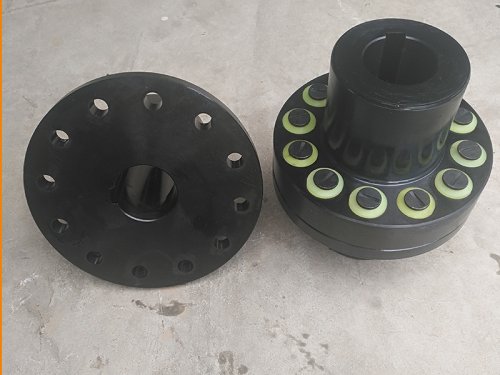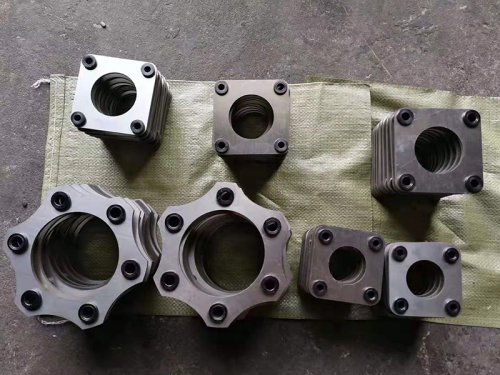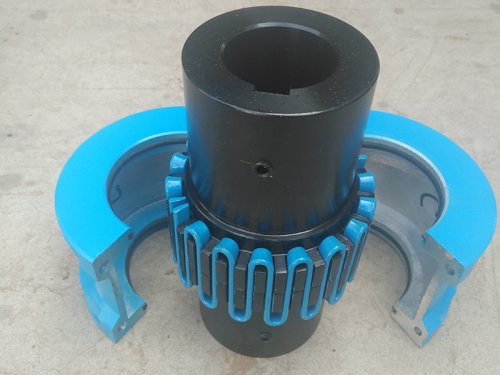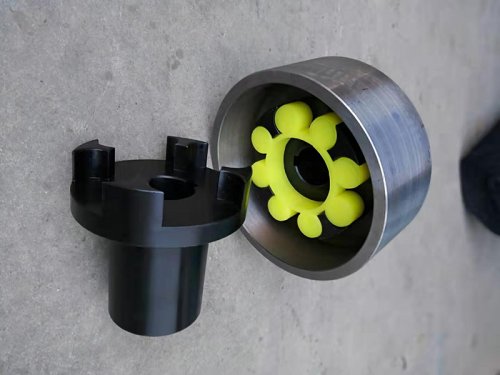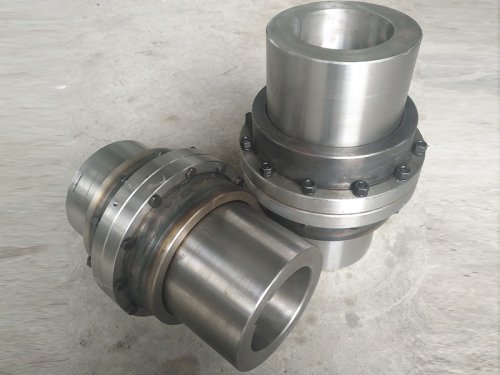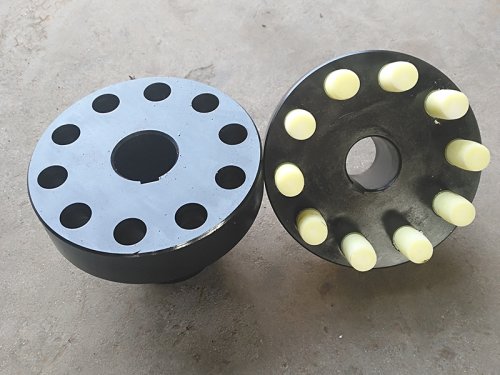categories of news
![]()
Popular products
MOREInfluencing factors of unbalance of serpentine spring coupling and transmission efficiency
Straight tooth profile serpentine spring coupling is a special shape of teeth machined on the flanges of the two halves of the coupling. A curved spring leaf is embedded between the tooth grooves. When working, the torque is reduced from one half of the coupling through the spring leaf. The shaft is transferred to the other half coupling.Its common structure, the shape of the tooth profile on the half coupling.Under normal load of this kind of coupling, the distance between the spring and the tooth contact point does not change with the change of spring deformation, so the stiffness remains unchanged. The relative rotation angle of the two halves of the coupling is in a linear relationship with the transmitted torque. Belongs to equal stiffness coupling.
The advantage of the linear tooth profile is that the tooth profile is relatively simple and the application is wider.The disadvantage is that it can only be used when the transmission torque changes little. Considering the transient overload and impact phenomena that may occur in use, when the transmission torque changes greatly, if the design is based on the normal load, the stiffness of the resulting elastic element will be smaller. When it is subjected to a large impact load, the deformation of the element is too large and exceeds the normal range, and there is a danger of failure; if the design is based on a large load, the stiffness of the obtained elastic element is greater, so that the elastic element under normal load The elasticity is not enough to provide the required cushioning effect.In order to overcome this shortcoming, according to the larger load, the spring strength and installation space and other conditions can be constrained, and the coupling rigidity is small as the goal. The optimization design can not only meet the requirements of the load-bearing capacity, but also make the rigidity. It is smaller, so it has a better result of good cushioning and damping performance, so that the above problems can be easily solved.
Due to various reasons, the center of mass or inertial principal axis of the coupling does not coincide with the axis of rotation, and the phenomenon of unbalanced centrifugal inertial force, centrifugal inertial couple force and dynamic deflection (vibration shape) will occur during operation, which is called the unbalance of the rotor. Phenomenon, this imbalance phenomenon will inevitably cause the vibration of the shaft system, thereby affecting the normal operation and service life of the machine, so it is important to pay attention to it.
The factors that affect the unbalance of the coupling have the following aspects.
1. The unbalance caused by the manufacturing tolerances specified in the design specifications of the main parts of the coupling (semi-coupling, etc.).
2. The unbalance caused by the eccentricity of the centering surface of the coupling and the shaft (the cylindricity of the shaft hole and its coaxiality with the outer edge).
3. The gap between matching parts in the coupling.
4. Unbalance caused by uneven or unsymmetrical distribution of accessories (threaded connections, keys, and shaft end pressing plates) in the coupling.
5. Unbalance caused by uneven material or uneven wear of each part of the coupling.
Under normal circumstances, designers do not need to design the coupling by themselves, and only need to design the coupling by themselves when the existing standard coupling cannot meet the needs.Standard couplings are easy to purchase, and the price is much cheaper than self-designed non-standard couplings.Among the many standard couplings, the correct choice of the coupling that suits your needs is related to the working performance, reliability, service life, vibration, noise, energy saving, transmission efficiency, transmission accuracy, and economy of the mechanical product shafting transmission. A series of problems are also related to the quality of mechanical products.
When selecting a coupling, the designer should choose the coupling based on the needs of the shafting transmission system, and should avoid simply considering the coupling of the main and driven ends.
(XNUMX) Mechanical characteristics of power machine
Between the power machine and the working time, the main and driven ends are connected through one or several couplings of different varieties or different types and specifications to form a shaft transmission system.In mechanical transmission, power machines are nothing more than electric motors, internal combustion engines and steam turbines.Due to the different working principles and structures of the power machines, their mechanical characteristics are very different. Some run smoothly, and some have shocks during operation, which have unequal effects on the transmission system.
The mechanical characteristics of the power machine have an impact on the entire transmission system. For different types of power machines, due to their different mechanical characteristics, the corresponding power machine coefficient KW should be selected, and the better coupling suitable for the system should be selected.The type of power machine is the basic factor for selecting the type of coupling; the power of the power machine is one of the main basis for determining the size of the coupling, and it is proportional to the torque of the coupling.
The power machines in the fixed mechanical product transmission system are mostly electric motors. The power machines in the running mechanical product transmission systems (such as Bobo, various vehicles, etc.) are mostly internal combustion engines. When the power machine is an internal combustion engine with different cylinder numbers, the torsional vibration should be considered. The influence of the transmission system is related to the number of cylinders of the internal combustion engine and whether each cylinder is working normally.In this case, flexible couplings should generally be used to adjust the natural frequency of the shaft system, reduce the torsional vibration amplitude, thereby damping, buffering, and protecting the transmission components, centering performance, and improving the stability of the output power.
(XNUMX) Load category
Due to different structures and materials, the couplings used in the transmission systems of various mechanical products have very different bearing capacities.The load category is mainly for the impact, vibration, forward and reverse rotation, braking, frequent start and other reasons of the working load of the working machine to form different types of loads.In order to facilitate selection and calculation, the load of the transmission system is divided into four categories.
The load category of the traditional system is the basic basis for selecting the type of coupling.For working loads with large changes in shock, vibration and transfer knowledge, flexible couplings with elastic elements, that is, elastic couplings, should be selected to buffer, reduce vibration, compensate for axis deviation, and drive system performance.The torque during frequent starting, forward and reverse rotation, and braking is several times the torque during normal and stable work. It is overload work, which will inevitably shorten the service life of the coupling elastic element. The coupling only allows short-term overload, generally short-term The overload shall not exceed 2~3 times of the nominal torque, ie [Tmax]≥2~3Tn.
Low-speed and heavy-duty working conditions should avoid the use of couplings that are only suitable for small and medium power, such as: elastic sleeve pin coupling, core-type elastic coupling, polygonal rubber coupling, tire coupling, etc.; For shafting systems that control overload protection, couplings should be selected; for shafting systems with large load changes and impacts and vibrations, flexible couplings with elastic elements and better cushioning and damping effects should be selected.The load-bearing capacity of the metal elastic coupling is higher than that of the non-metal elastic element; the reliability of the elastic coupling with the elastic element being squeezed is higher than that of the elastic coupling with the elastic element being sheared.
(XNUMX) Allowable speed of coupling
The allowable speed range of the coupling is determined by calculation based on the larger outer edge size of the allowable linear speed of different materials of the coupling.The allowable speed range of couplings of different materials, varieties and specifications is different. Changing the material of the coupling can increase the allowable speed range of the coupling. The allowable speed for steel is greater than the allowable speed for cast iron.
(XNUMX) Relative displacement of the two shafts connected by the coupling
The two shafts connected by the coupling produce relative displacement due to many factors such as manufacturing error, assembly error, installation error, shaft load and deformation, base deformation, bearing wear, temperature change, and relative movement between components.Under normal circumstances, the relative displacement of the two shafts is unavoidable, but the direction of the equilibrium displacement generated by the shafting transmission under different working conditions, that is, the axial, radial angular direction and the magnitude of the displacement are different.Only the flexible coupling has the performance of compensating the relative displacement of the two shafts. Therefore, a large number of flexible couplings are selected in practical applications.Rigid couplings are not compensatory and the application range is limited, so the amount is very small.Universal couplings should be used for shafting transmissions with large angular displacement; for shafting transmissions with axial movement and need to control axial displacement, diaphragm couplings should be used; only those with high alignment accuracy Rigid coupling is selected only below.
(XNUMX) Transmission accuracy of the coupling
The small torque and the transmission of the main shaft system require the coupling to have high transmission accuracy, and the flexible coupling with metal elastic elements should be used.The shafting transmission with large torque and power transmission also has requirements for transmission accuracy. At high speeds, avoid the use of flexible couplings with non-metallic elastic components and gaps between the flexible couplings and movable components. It is better to choose Diaphragm coupling with high transmission accuracy.
(XNUMX) Coupling size, installation and maintenance
The outer dimensions of the coupling, that is, the larger radial and axial dimensions, are within the allowable installation space of the machine and equipment.Choose a coupling that is convenient for assembly and disassembly, does not require maintenance, has a long maintenance period or is convenient for maintenance, does not need to move the two shafts when changing wearing parts, and is easy to align and adjust.
It is difficult for large machinery and equipment to adjust the alignment of the two shafts. Choose a coupling that is durable and easy to change wearing parts.Flexible couplings with metal elastic elements generally have a longer service life than flexible couplings with non-metal elastic elements.The need for sealing and lubrication and the use of non-durable couplings will inevitably increase maintenance workload.For occasions with long-term continuous operation and high economic benefits, such as the high-increasing end of the rolling mill transmission system of my country's metallurgical enterprises, the upper gear coupling is currently commonly used. Although the gear coupling theoretically transmits a large torque, it is lubricated It can work for a long time only under the conditions of good sealing and good sealing, and it is necessary to check the sealing condition frequently, inject lubricating oil, and maintain a large amount of work, which increases auxiliary man-hours, reduces working hours, and affects production efficiency.
(XNUMX) Working environment
The coupling functions as a complete set of various host products, and the surrounding working environment is more complicated.For the working environment with high temperature, low temperature, oil, acid and alkali medium, it is not suitable to choose flexible couplings with general rubber as the elastic element material, but should choose flexible couplings with metal elastic elements.The elastic pin gear coupling has high noise due to the movement of the pin during operation. It should not be used in occasions with strict requirements for noise.

